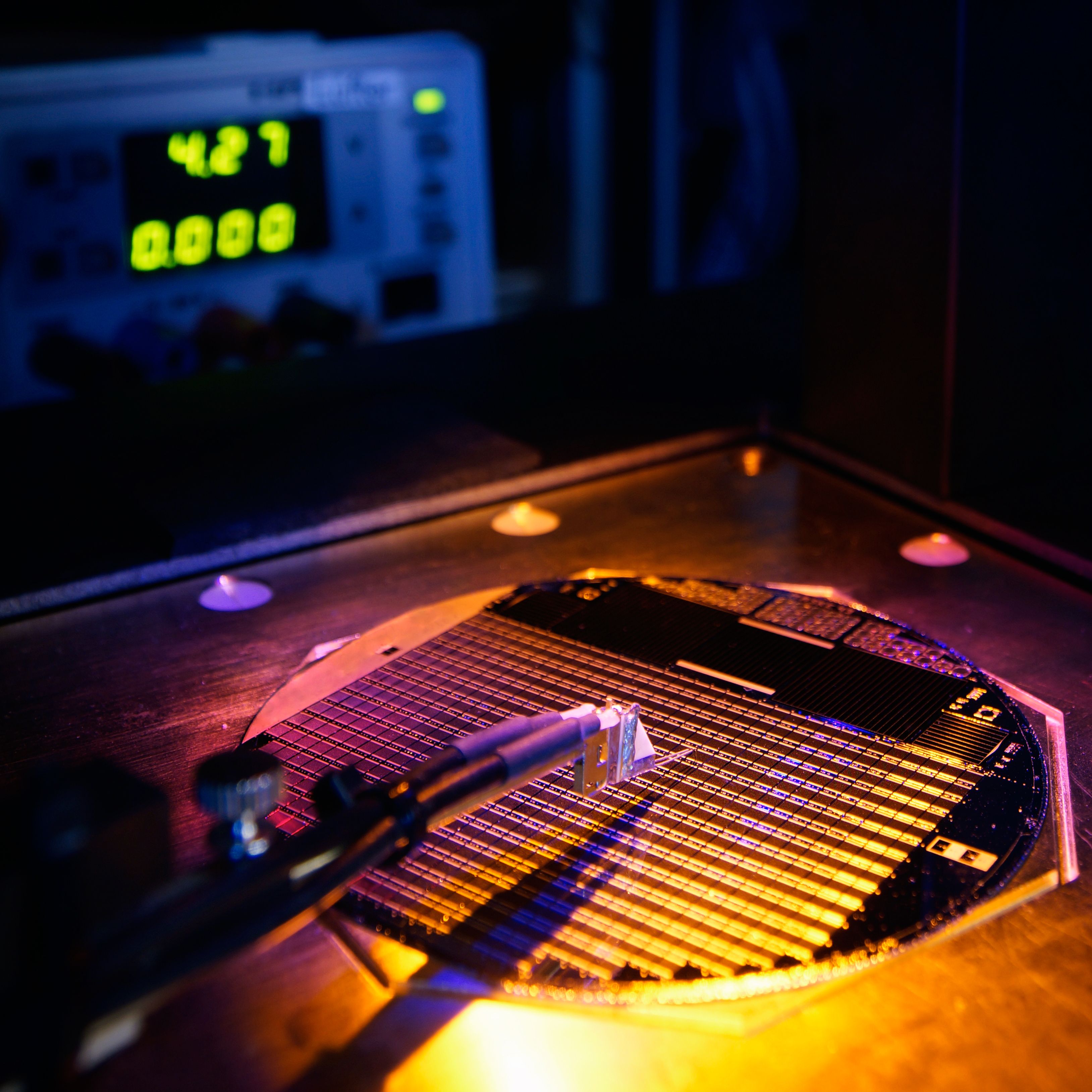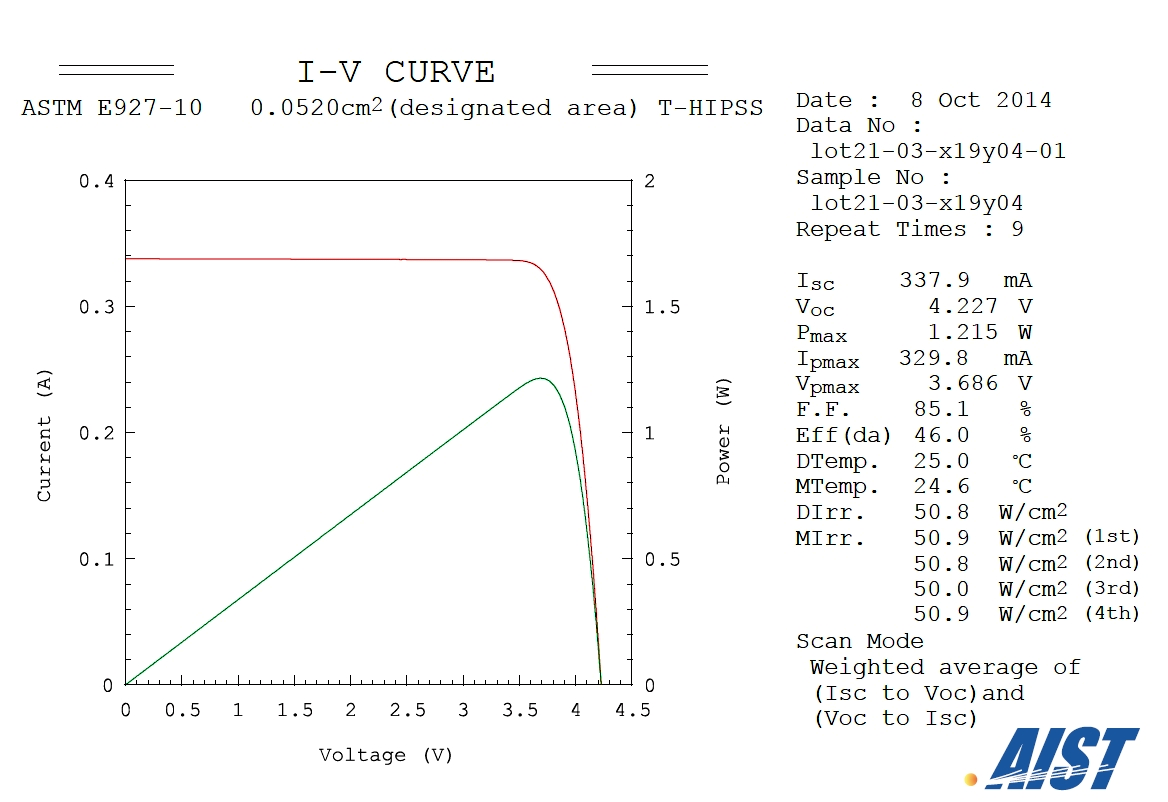Press Release #26
New world record for solar cell efficiency at 46% – French-German cooperation confirms competitive advantage of European photovoltaic industry
A new world record for the direct conversion of sunlight into electricity has been established. The multi-junction solar cell converts 46% of the solar light into electrical energy and was developed by Soitec and CEA-Leti, France, together with the Fraunhofer Institute for Solar Energy Systems ISE, Germany. Multi-junction cells are used in concentrator photovoltaic (CPV) systems to produce low-cost electricity in photovoltaic power plants, in regions with a large amount of direct solar radiation. It is the cooperation’s second world record within one year, after the one previously announced in September 2013, and clearly demonstrates the strong competitiveness of the European photovoltaic research and industry. Multi-junction solar cells are based on a selection of III-V compound semiconductor materials. The world record cell is a four-junction cell, and each of its sub-cells converts precisely one quarter of the incoming photons in the wavelength range between 300 and 1750 nm into electricity. When applied in concentrator PV, a very small cell is used with a Fresnel lens, which concentrates the sunlight onto the cell. The new record efficiency was measured at a concentration of 508 suns and has been confirmed by the Japanese AIST (National Institute of Advanced Industrial Science and Technology), one of the leading centers for independent verification of solar cell performance results under standard testing conditions.


A special challenge that had to be met by this cell is the exact distribution of the photons among the four sub-cells. It has been achieved by precise tuning of the composition and thicknesses of each layer inside the cell structure. ”This is a major milestone for our French-German collaboration. We are extremely pleased to hear that our result of 46% efficiency has now been independently confirmed by AIST in Japan”, explains Dr. Frank Dimroth, project manager for the cell development at the German Fraunhofer Institute for Solar Energy Systems ISE. “CPV is the most efficient solar technology today and suitable for all countries with high direct normal irradiance.”
Jocelyne Wasselin, Vice President Solar Cell Product Development for Soitec, a company headquartered in France and a world leader in high performance semiconductor materials, says: “We are very proud of this new world record. It confirms we made the right technology choice when we decided to develop this four-junction solar cell and clearly indicates that we can demonstrate 50% efficiency in the near future.” She adds: “To produce this new generation of solar cells, we have already installed a line in France. It uses our bonding and layer-transfer technologies and already employs more than 25 engineers and technicians. I have no doubt that this successful cooperation with our French and German partners will drive further increase of CPV technology efficiency and competitiveness.”
About Soitec
Soitec is an international manufacturing company, a world leader in generating and manufacturing revolutionary semiconductor materials at the frontier of the most exciting energy and electronic challenges. Soitec’s products include substrates for microelectronics (most notably SOI: Silicon-on-Insulator) and concentrator photovoltaic systems (CPV). The company’s core technologies are Smart Cut™, Smart Stacking™ and Concentrix™, as well as expertise in epitaxy. Applications include consumer and mobile electronics, microelectronics-driven IT, telecommunications, automotive electronics, lighting products and large-scale solar power plants. Soitec has manufacturing plants and R&D centers in France, Singapore, Germany and the United States. www.soitec.com
About CEA-Leti (France)
By creating innovation and transferring it to industry, Leti is the bridge between basic research and production of micro- and nanotechnologies that improve the lives of people around the world. Backed by its portfolio of 2,200 patents, Leti partners with large industrials, SMEs and startups to tailor advanced solutions that strengthen their competitive positions. It has launched more than 50 startups. Its 8,000m² of new-generation cleanroom space feature 200mm and 300mm wafer processing of micro and nano solutions for applications ranging from space to smart devices. Leti’s staff of more than 1,700 includes 200 assignees from partner companies. Leti is based in Grenoble, France, and has offices in Silicon Valley, Calif., and Tokyo. www.leti.fr
About Fraunhofer ISE
With a staff of 1300, the Fraunhofer Institute for Solar Energy Systems ISE, based in Freiburg, is the largest solar energy research institute in Europe. Fraunhofer ISE is committed to promoting energy supply systems which are sustainable, economic, safe and socially just. It creates the technological foundations for supplying energy efficiently and on an environmentally sound basis. To this end, the institute develops materials, components, systems and processes for energy efficiency, energy conversion, energy distribution and energy storage. The Institute is a member of the Fraunhofer-Gesellschaft, Europe’s largest application-oriented research organization. www.ise.fraunhofer.de
Scientific publications about this topic:
- F. Dimroth, M. Grave, P. Beutel, U. Fiedeler, C. Karcher, T.N.D. Tibbits, E. Oliva, G. Siefer, M. Schachtner, A. Wekkeli, A.W. Bett, R. Krause, M. Piccin, N. Blanc, C. Drazek, E. Guiot, B. Ghyselen, T. Salvetat, A. Tauzin, T. Signamarcheix, A. Dobrich, T. Hannappel and K. Schwarzburg, Wafer bonded four-junction GaInP/GaAs//GaInAsP/GaInAs concentrator solar cells with 44.7% efficiency. Progress in Photovoltaics: Research and Applications, 2014. 22(3): p. 277-282.
- F. Dimroth, T. Roesener, S. Essig, C. Weuffen, A. Wekkeli, E. Oliva, G. Siefer, K. Volz, T. Hannappel, D. Haussler, W. Jager and A.W. Bett, Comparison of direct growth and wafer bonding for the fabrication of GaInP/GaAs dual-junction solar cells on silicon. IEEE Journal of Photovoltaics, 2014. 4(2): p. 620-625.
- T.N.D. Tibbits, P. Beutel, M. Grave, C. Karcher, E. Oliva, G. Siefer, A. Wekkeli, M. Schachtner, F. Dimroth, A.W. Bett, R. Krause, M. Piccin, N. Blanc, M. Muñoz-Rico, C. Arena, E. Guiot, C. Charles-Alfred, C. Drazek, F. Janin, L. Farrugia, B. Hoarau, J. Wasselin, A. Tauzin, T. Signamarcheix, T. Hannappel, K. Schwarzburg and A. Dobrich, New efficiency frontiers with wafer-bonded multi-junction solar cells. in Proceedings of the 29th European Photovoltaic Solar Energy Conference. 2014. Amsterdam, Netherlands. p. 1975 - 1978.
Last modified: